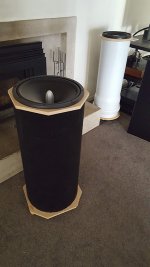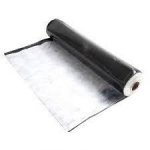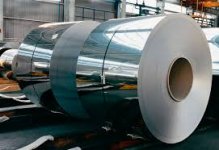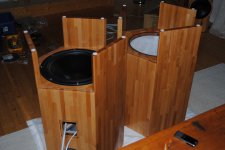I used a section of this that I pulled out of a skip on a construction site. Twin walled = more rigid.
PRO Pipe Systems - Vinidex
Try "corrugated plastic stormwater pipe" as a google search.
I found that kind of tubes.
But they are "profiled", I do not get smooth too mutch.
I would have preferred a thicker and smoother wall on the outside because of a termination theme, I thought to cover the cylinder with black jersey cloth and make the base and top in varnished wood .....
This complicates me, the fabric will not take the shape of the ribbed .... I will continue investigating....
There are no opinions on aluminum tubes, why? Are they very resonant? is that ?
You might be overthinking this.
What you put in post 6 would be fine: PVA with a bit of internal reinforcing.
The only reason I used the stronger corrugated pipe is cos it was free 🙂
What you put in post 6 would be fine: PVA with a bit of internal reinforcing.
The only reason I used the stronger corrugated pipe is cos it was free 🙂
I used to put one sonotube inside another with half an inch between them and fill the space with clean sand. It made a really dense dead cabinet. I routed slots in the end caps to set the rings evenly apart. In
Addition to damping material inside I mounted the woofers cutout piece at an angle half way down allowing air to pass freely to break up standing waves. True it, you’ll like it!
Addition to damping material inside I mounted the woofers cutout piece at an angle half way down allowing air to pass freely to break up standing waves. True it, you’ll like it!
Concur about not needing reinforcing. PVC cylinders are super-rigid anyway -it's akin to trying to squash an egg end-on, hard to do - especially if you find the right type (of cylinder not egg), typically sewer or pressure pipe from building sites. Generally the contractors give away off-cuts if you ask them nicely. It's expensive as hell to buy.
I've used it for plenty of different sized subs and would never go back to building boxes again. Mine are sealed subs. Do they look good? Not much; I've never quite discovered how to 'paint' over the shiny plastic, though I have a few cans of liquid plastic paint I'm going to try out at some point (automotive stuff).
I've used it for plenty of different sized subs and would never go back to building boxes again. Mine are sealed subs. Do they look good? Not much; I've never quite discovered how to 'paint' over the shiny plastic, though I have a few cans of liquid plastic paint I'm going to try out at some point (automotive stuff).
Do they look good? Not much; I've never quite discovered how to 'paint' over the shiny plastic, though I have a few cans of liquid plastic paint I'm going to try out at some point (automotive stuff).
A couple of light coats of Hammer paint / hammerglaze would probably work, it seems to stick to anything.
I like how it looks + it is a bit textural, and needs little surface preparation.
IMO it looks good over a purposely flailed / stippled / textured surface, but YMMV there... phobic response
think you need to prep well and use plastic primer paint before applying something like Hammerite paint?
I wouldn't think so, based on its other applications - but I haven't tried it on plastic. I could give a test scrap a try and see how it goes.
I guess this i all about cylindrical subwoofers but I built a hexagonal pair our of 28mm thick beech benchboard that I got from IKEA.
3 sides worked as legs, the other 3 ended at baffle about 15cm above the floor.
It had a reinforcement that also supported the vent.
The vent vas 110mm pvc tube and angled 90 deg (2x45) to fit the length.
Also the top was reinforced heavily.
The woofers was 15 inch Monacor subwoofers tunded to FS.
They sounded really nice and played very deep with dry bass.
//Figge
3 sides worked as legs, the other 3 ended at baffle about 15cm above the floor.
It had a reinforcement that also supported the vent.
The vent vas 110mm pvc tube and angled 90 deg (2x45) to fit the length.
Also the top was reinforced heavily.
The woofers was 15 inch Monacor subwoofers tunded to FS.
They sounded really nice and played very deep with dry bass.
//Figge
Thanks to all.
I really have a hard to find tubes...( of any material ) 😡 , in so little quantities .
But I'll keep trying....😎
I really have a hard to find tubes...( of any material ) 😡 , in so little quantities .
But I'll keep trying....😎
You might be overthinking this.
What you put in post 6 would be fine: PVA with a bit of internal reinforcing.
The only reason I used the stronger corrugated pipe is cos it was free 🙂
If, that is the goal, I have to look for some deposit of disused materials (vials and / or construction) ...😉
Well, it looks like I can get iron cylinders.....😕
Dimensions: 0.60 mts. diameter x 1 mts. height x 2.8 mm wall thickness.
Reading and reading I draw these conclusions, correct if I'm wrong please .:
There will be no resonance problems because given the dimensions and shape of the structure, they will be well above the subwofer's frequency range.
But, as you can see here, - See post 23 - (nobody clarified this point that seemed very important to me)
Metal Speaker Enclosures ? A bad idea ?
Iron is a highly magnetic material and the distance between the cylinder wall and the magnet of the speaker is approximately 0.20 meters.
So the questions are:
Can this magnetic interaction affect (if any) the performance of the speaker?
Is there any practical way to shield the cylinder walls to avoid the problem?
Bituminous membranes with aluminum walls would they serve?
Dimensions: 0.60 mts. diameter x 1 mts. height x 2.8 mm wall thickness.
Reading and reading I draw these conclusions, correct if I'm wrong please .:
There will be no resonance problems because given the dimensions and shape of the structure, they will be well above the subwofer's frequency range.
But, as you can see here, - See post 23 - (nobody clarified this point that seemed very important to me)
Metal Speaker Enclosures ? A bad idea ?
Iron is a highly magnetic material and the distance between the cylinder wall and the magnet of the speaker is approximately 0.20 meters.
So the questions are:
Can this magnetic interaction affect (if any) the performance of the speaker?
Is there any practical way to shield the cylinder walls to avoid the problem?
Bituminous membranes with aluminum walls would they serve?
Attachments
Last edited:
1) The magnetic influence drops at somewhere between an inverse square and inverse cube rate-at .2 meters an iron tube surrounding the magnet structure would have virtually no effect in the gap.Iron is a highly magnetic material and the distance between the cylinder wall and the magnet of the speaker is approximately 0.20 meters.
So the questions are:
1)Can this magnetic interaction affect (if any) the performance of the speaker?
2)Is there any practical way to shield the cylinder walls to avoid the problem?
3)Bituminous membranes with aluminum walls would they serve?
2) No, but fortunately it's not needed.
3) Yes. Both aluminum and iron have been used, with damping material applied, for mid/high frequency horns for almost 100 years.
Cylinders reduce flexing, so thinner materials can be used and still be "stiff" compared to conventional plywood or MDF construction.
Using metal (rather than plastic or cardboard) and then needing to use damping material to eliminate "ringing" makes construction more difficult.
Art
Thank you weltersys ! , that's good news for me 🙂 , I have experience in working the metal and placing the bituminous material will not be a problem because the cylinders will have little height.
Now I'm depending on the new availability of cylinders of 0.60 meters in diameter, they offered me 0.50 meters, but for an 18-inch's driver the design of the base was very tight.
Can you imagine where the tubes that were offered came from ? 😀
Now I'm depending on the new availability of cylinders of 0.60 meters in diameter, they offered me 0.50 meters, but for an 18-inch's driver the design of the base was very tight.
Can you imagine where the tubes that were offered came from ? 😀
Attachments
Locally we have the generic sonotube equivalents that are very flimsy. But available at the concrete supply store is a version that is a hair under 1/4" thick. It is solid. The 18" version I have I can sit on and it flexes maybe 3/4". Springing right back when I get off. Given the success others have had with the much flimsier versions, I don't think it will resonate. I plan to cover it in prefinished aluminum coil with contact cement. Perhaps there is something similar available there for you. Craig
Hexagonal 15 inch subwoofers
This is the only picture that I could find. It was 9 years ago, and I sold them in 2013.
The woofers were these ones MONACOR - Products - SPH-380TC
Out of memory the volume vas 135 liters tuned to 21 Hz.
The coils were in parallell, each woofer driven by one channel from a Alto MAC2400.
/Figge
This is the only picture that I could find. It was 9 years ago, and I sold them in 2013.
The woofers were these ones MONACOR - Products - SPH-380TC
Out of memory the volume vas 135 liters tuned to 21 Hz.
The coils were in parallell, each woofer driven by one channel from a Alto MAC2400.
/Figge
Attachments
Thanks to all.
I really have a hard to find tubes...( of any material ) 😡 , in so little quantities .
But I'll keep trying....😎
Concrete?
Very low resonance.
Affordable.
Some like the look.
Roll your own
YouTube
Thanks, but ......Concrete?
Very low resonance.
Affordable.
See post 15 ...😀
Last edited:
Perhaps there is something similar available there for you. Craig
Thanks friend.🙂
- Status
- Not open for further replies.
- Home
- Loudspeakers
- Subwoofers
- Materials for cylindrical subwofers ?




